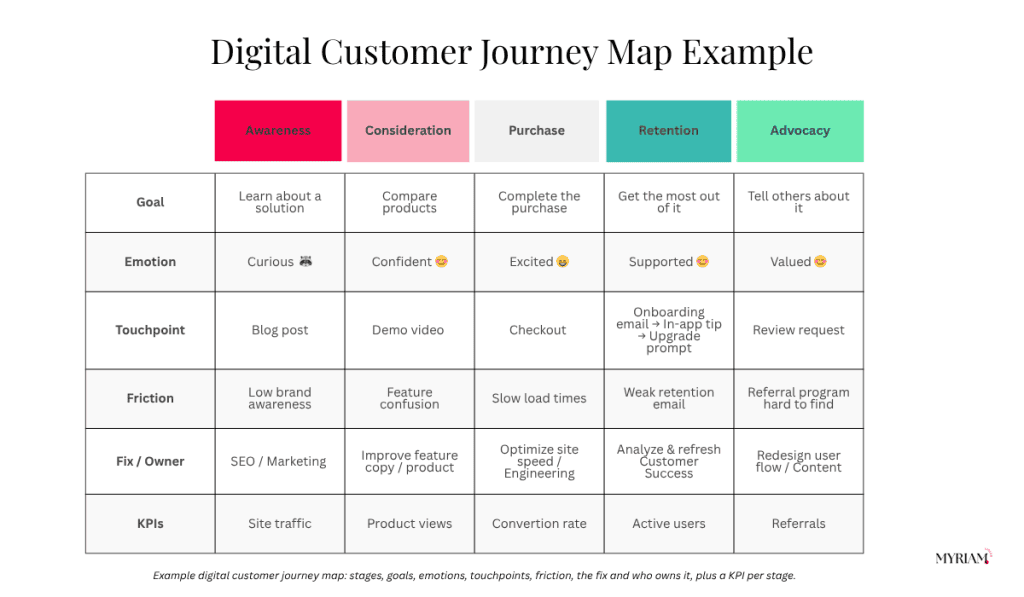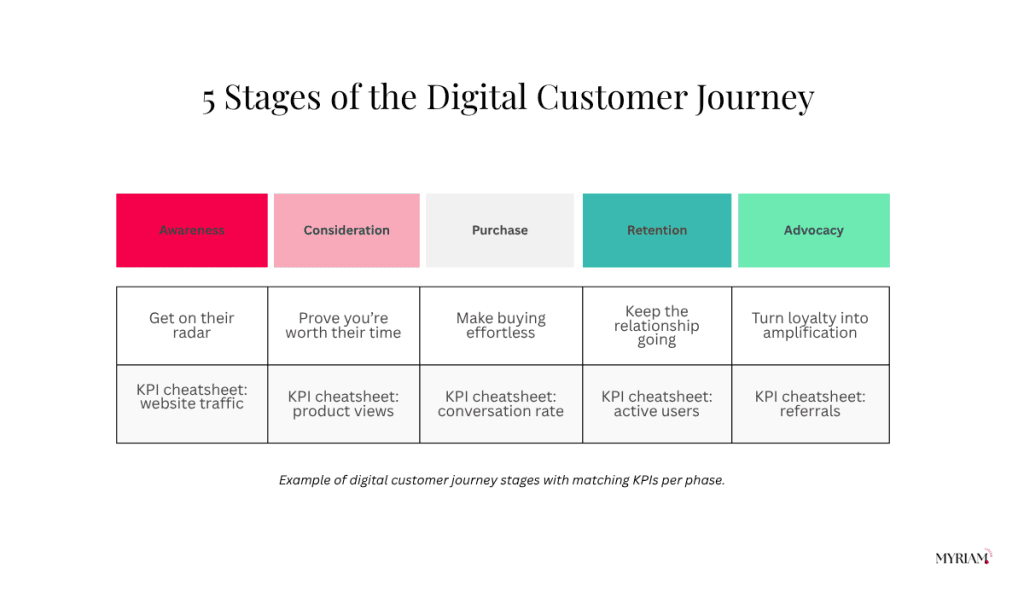The digital customer journey is how people move from first discovering your brand to becoming repeat buyers or advocates. This post explains what a digital journey map is, why it matters, and how to improve every stage —from awareness to loyalty—with practical, human strategies that actually work.
TL;DR: Optimizing Your Digital Customer Journey
TL;DR
👉🏻 Map the different stages of the digital journey.
👉🏻 Fix the highest-impact customer touchpoints.
👉🏻 Personalize the experience and streamline checkout.
👉🏻 Track KPIs monthly, test, iterate.
👉🏻 Ask for reviews, referrals, and UGC.
Digital Customer Journey Map: Why Mapping Every Stage Matters
A digital customer journey map shows how people discover you, evaluate you, buy from you, and come back. Mapping the customer journey gives you a clear view of what earns attention and what causes drop-off.
Why this matters now:
• Customers move across channels and devices in seconds.
• A digital customer journey map highlights the moments that shape decisions.
• You can improve what works and fix friction where it appears.
What you will get from this guide:
• A simple customer journey mapping process you can run with your team.
• The five stages of the digital customer journey and what to watch in each.
• Practical ways to optimize the digital customer journey without adding complexity.
Key components of a Digital Customer Journey Map
A solid digital customer journey map captures more than steps. It shows what your customers feel and need at every point. Build yours around these six elements:
- Customer personas: quick profiles of your main audience segments, who they are, what motivates them, and how they decide.
- Journey stages: awareness, consideration, decision, retention, and advocacy.
- Touchpoints: each digital interaction, from ads and emails to support chats and checkout.
- Goals and expectations: what customers hope to achieve at each stage and how they expect you to help.
- Pain points: moments of friction or frustration that block progress.
- Emotions: how customers feel along the way, from curiosity to confidence.
Together, these pieces give you a clear, human view of your customer experience and the insight to make it better.
How to create a Digital Customer Journey Map step by step
Building a journey map is about understanding real behavior. Use these six steps to design a map that reflects how customers move, decide, and feel.
Step 1 – Research your audience
Start with facts, not assumptions. Combine surveys, interviews, focus groups, and analytics to learn who your customers are, how they buy, and what drives their choices. This grounds the customer journey mapping process in facts rather than guesses. For help choosing the right interview and survey prompts, explore these customer journey questions you can use at each stage.
Step 2 – Create data-driven personas
Turn your findings into clear personas. Capture goals, challenges, and decision triggers so you can speak their language and anticipate what they need next.
Step 3 – Segment for focus
Group customers by similar behaviors or preferences, for example, first-time buyers, repeat customers, or high-engagement users. Segmentation lets you tailor experiences that feel personal.
Step 4 – Define the journey stages
Outline the five stages of the digital customer journey, then note the main actions, questions, and channels at each stage.
Step 5 – Clarify goals and expectations
At every stage, ask: what is the customer trying to accomplish, and what do they expect from us?
Step 6 – Spot and fix friction
List pain points such as slow pages, missing info, confusing checkout, or long support waits. Each fix removes a barrier and improves the experience.
Keep refining your digital customer journey map as new data comes in. Small updates over time build trust and growth.

Digital Customer Journey Map Example (quick template) (moved here)
- Awareness: blog post, comparison page, social ad
- Consideration: demo video, pricing page, case study
- Purchase: checkout page, payment step, confirmation
- Retention: onboarding email, help center, in-app tips
- Advocacy: review request, referral link, UGC prompt
How to Optimize the Digital Customer Journey for Engagement and Conversion
Think of your digital customer journey as a story. Every click, scroll, or email is a chance to keep readers engaged or lose them. The goal is to make every step feel effortless.
You will learn how to:
- Strengthen engagement by tuning the right touchpoints.
- Turn minor improvements into higher conversions and repeat customers.
- Use real data to personalize what people see, click, and buy.
Every journey follows five stages. When each one works together, customers do not just convert once. They stay.

The Five Stages of the Digital Customer Journey
Every customer follows a path. Here is how to make each stage work harder for you. Want a deeper breakdown of what happens at each phase? Explore the complete overview of the customer journey stages to see how awareness, consideration, decision, retention, and advocacy fit together.
1. Awareness: Get on their radar
Create content that solves real problems and shows up where they search. Social posts, search ads, and smart SEO do the heavy lifting.
2. Consideration: Prove you are worth their time
Give honest reviews, clear pricing, and helpful comparisons. The more transparent you are, the easier the decision becomes.
3. Purchase: Make buying effortless
Do not let checkout be the blocker. Offer simple payment options, fast load times, and clear shipping info. Anticipate objections before they arise.
4. Retention: Keep the relationship going
After purchase, keep talking. Personalized emails, small loyalty perks, and quick check-ins remind customers they matter.
5. Advocacy: Turn loyalty into amplification
Make it easy to leave a review, tag you online, or share a referral link. When customers talk, others listen.
Best practices to optimize the digital customer journey
Small tweaks make a big difference. Here is how to make the journey faster, smoother, and more enjoyable.
1. Make your website responsive on any device
Your site should look great and load fast on phones, tablets, and desktops. Clean layouts, clear navigation, and lightweight images prevent bounce. Mobile commerce in the U.S. is expected to hit 432 billion dollars, making responsive design essential.
2. Give buyers the details they actually need
Use short paragraphs, bullets, and real photos. Focus on price, benefits, and results. Add genuine reviews. Ninety-one percent of people read them before buying, and they can lift sales by 270 percent.
3. Be easy to reach across multiple customer channels
Offer live chat for quick questions, email for follow-ups, and a phone line for complex issues. If you use chatbots, make the handoff to humans smooth.
4. Personalize like you mean it
Send emails that feel written for the reader. Show recommendations based on past actions. Personal touches can increase opens by 29% and clicks by 41%.
5. Streamline the checkout process
Cut extra fields, offer guest checkout, and keep progress clear. Saved payment options and auto-fill turn hesitation into a sale. A well-designed checkout can lift conversions by up to 35 percent.
Review analytics monthly. Keep what works. Fix what does not. A friction-free experience turns browsers into buyers, and buyers into fans.
Customer Touchpoints that Drive Customer Engagement and Loyalty
From your website to socials, email, and ads, every interaction adds up to one big impression. Get those moments right and loyalty follows.
Identify key digital customer touchpoints
Here is how to pinpoint what drives engagement:
1. Map the full customer journey
Lay out every stage from awareness to advocacy. Use a simple journey map to show where people interact with you, such as your website, ads, social media, support, and email. Seeing it in one place makes friction and opportunity obvious.
2. Back it up with data
Review web analytics, social engagement, email open rates, and ad performance. Data shows which channels convert and which just look busy.
Optimize customer touchpoints for a consistent experience (condensed and deduped)
Make each interaction feel like it comes from one brand. Use the same tone, design cues, and promises across the site, email, ads, and support. Set clear next steps on every page and message. Test copy and placement until the path forward is obvious. Keep content aligned to what customers need at each stage and keep it current.
Use social proof to lift customer engagement
People trust people more than brands.
1. Show up and engage: reply quickly to comments, questions, and feedback.
2. Share customer stories: invite photos, videos, and reviews, and use influencer collaborations that fit your values. Real voices drive attention, credibility, and conversions.
The year ahead will reward brands that personalize and stay flexible. Keep refining how you use social data and feedback so every interaction feels more authentic.
Common Digital Customer Journey mistakes to avoid (moved here)
- No clear mapping or owner per stage
- Generic messaging across the five stages
- Ignoring post-purchase experience and referrals
- Measuring traffic only, not conversion and retention
Measure the Digital Customer Journey: KPIs, Analytics, and Iteration
TL;DR
👉🏻 Set clear KPIs for every stage.
👉🏻 Use analytics to see what customers do.
👉🏻 Review results often and adjust fast.
Tracking movement through your digital customer journey is how you learn what works and what slows people down. Use these metrics to optimize the digital customer journey without overcomplicating your stack.
Set KPIs for each stage of the journey
If you cannot measure it, you cannot improve it. Choose metrics that link to business goals and that your team can track.
Examples by stage:
| Stage | Key metrics to watch |
|---|---|
| Awareness | Website traffic, social reach, ad click-throughs |
| Consideration | Product page views, time on site, email sign-ups |
| Decision | Conversion rate, cart abandonment, average order value |
| Retention | Lifetime value, repeat purchases, churn |
| Advocacy | NPS, referrals, social mentions |
Pick SMART KPIs: specific, measurable, achievable, relevant, time-bound. Track regularly. Adjust when something dips.
Implement analytics across touchpoints
Connect the dots across every digital touchpoint so you can see how people move, click, and convert.
- Google Analytics: traffic, behavior, conversion flow
- Heatmaps: where visitors scroll, pause, or drop off
- CRM systems: interactions, purchase history, preferences
- Social analytics: engagement, reach, sentiment
- A/B testing tools: compare pages or CTAs to see what performs
When you review these sources together, you stop guessing and see clear patterns.
Analyze, test, and improve the customer experience
Collecting data is easy. Turning it into action drives growth. Set a regular rhythm for reviewing numbers, spotting patterns, and testing improvements.
Focus on four areas:
Traffic and bounce rates: slow pages or weak content cause exits. Fix basics first.
Conversion rate and order value: improve checkout flow, product pages, and timing.
Retention and lifetime value: find what your best customers share and double down.
NPS and satisfaction: use feedback to guide updates to product, service, or support.
Review, test, improve, repeat. That cycle turns metrics into momentum.
From Customer Engagement to Advocacy: Build Loyalty Across Stages
TL;DR
👉🏻 Keep experiences personal.
👉🏻 Turn happy buyers into advocates.
👉🏻 Use digital channels to build relationships that last.
Loyalty is earned through every interaction that feels relevant and human.
Create a digital customer journey that builds loyalty
1. Map the full journey
Outline every stage and touchpoint, from awareness to post-purchase. Note what customers want and where they struggle.
2. Personalize every interaction
Show relevant products, send helpful content, and speak to real needs.
3. Engage across channels
Stay consistent across website, social, email, and app.
4. Reward loyalty early
Thank-you messages, points, or early access can turn occasional buyers into regulars.
5. Provide incredible customer service
Fast, friendly support turns problems into trust builders.
Long-term customer engagement strategies
1. Listen and act on feedback
Ask for opinions and use what you learn. Fixing issues people raise builds trust fast.
2. Offer value beyond what you sell
Share tips, resources, and insights that make customers’ lives easier.
3. Turn customers into advocates
Invite stories, reviews, and referrals. Give simple ways to share and say thanks when they do.
Consistent listening, added value, and authentic advocacy keep your journey strong long after checkout.
What’s Next for the Digital Customer Journey
TL;DR
👉🏻 AI and machine learning make personalization smarter.
👉🏻 Voice tools change how people interact.
👉🏻 AR, VR, blockchain, and IoT keep reshaping what a digital experience can be.
The next wave is about context and connection: smarter recommendations, seamless conversations, and experiences that feel almost effortless. Choose the tools that make life easier for customers.
AI and machine learning for personalized customer experience
AI is already here. Every click and purchase teaches your system what customers want.
Research shows 80 percent of consumers are more likely to buy from brands that personalize, and AI-driven personalization could add 1.7 trillion dollars in value by 2026. Amazon, Netflix, and Spotify have set the expectation. Your customers now expect the same.
Voice search and conversational interfaces for seamless interactions
People expect to ask a question and get an instant answer. In 2025, voice interactions continue to grow, with estimates that nearly one in three customer interactions occur through voice. Optimize content for voice and use conversational tools that feel natural. Domino’s shows the idea in action with smart speaker ordering.
Augmented reality and virtual reality for immersive customer experiences
AR helps shoppers see how a sofa fits their room. VR can walk them through a new home. The market is expected to reach 95 billion dollars in 2025, and IKEA’s Place app shows how immersion builds confidence to buy.
Blockchain technology for secure and transparent transactions
A decentralized ledger makes payments safer and data handling more transparent. A PwC report notes that 84 percent of organizations are exploring blockchain. IBM and Walmart use it to verify supply chains and improve food safety, giving customers proof, not promises.
Internet of Things (IoT) for connected and context-aware journeys
When devices share data in real time, you can predict needs and remove friction. McKinsey estimates IoT could reach 11.1 trillion dollars in 2025. Disney’s MagicBand shows how this feels on the ground with tap-to-pay, shorter waits, and timely recommendations.
Bring it together: Optimizing Your Digital Customer Journey
Understanding your customer journey is how you keep your business sharp. It shows where things work, where they do not, and what needs to change.
Start simple. Build personas that reflect real people. Find the friction points, fix them, and keep checking that every touchpoint still does its job.
Use data to guide decisions. Personalize what matters. Keep support responsive.
Stay alert to change, but focus on what improves the experience right now.
Where do customers hesitate? Where do they leave happy? Start there. Then improve one step at a time.
A digital customer journey shows how people find, choose, and stay with your brand. This guide breaks down each stage — awareness, consideration, purchase, retention, and advocacy — and explains how to improve touchpoints, personalize experiences, and measure results without overcomplicating the process. You’ll walk away knowing how to spot friction, build loyalty, and use data in a way that makes sense for both your customers and your team.







